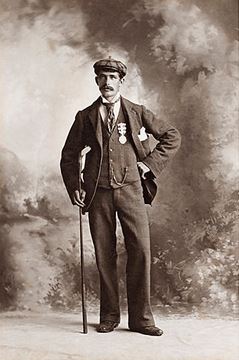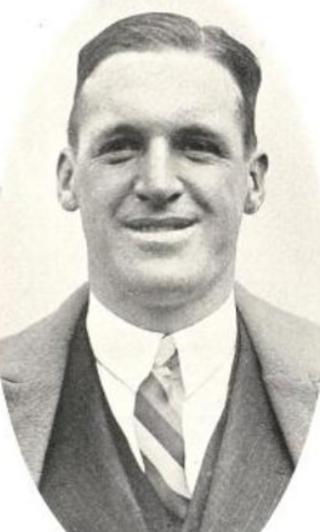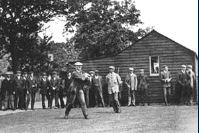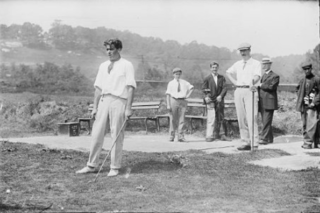
The Open Championship, often referred to as The Open or the British Open, is the oldest golf tournament in the world, and one of the most prestigious. Founded in 1860, it was originally held annually at Prestwick Golf Club in Scotland. Later the venue rotated between a select group of coastal links golf courses in the United Kingdom. It is organised by The R&A.

James Braid was a Scottish professional golfer and a member of the Great Triumvirate of the sport alongside Harry Vardon and John Henry Taylor. He won The Open Championship five times. He also was a renowned golf course architect. Braid is a member of the World Golf Hall of Fame.

Lawrence Auchterlonie was a Scottish professional golfer, a native of St Andrews. In 1902, representing the Glen View Club, he won the eighth U.S. Open at Garden City Golf Club in Garden City, New York.

Fred Herd was a Scottish professional golfer from St Andrews. In 1898, he won the fourth U.S. Open at Myopia Hunt Club, in South Hamilton, Massachusetts. This was the first U.S. Open to be played over 72 holes, requiring the competitors to play eight rounds of Myopia's nine-hole course. Herd turned in a card totaling 328, 84-85-75-84, averaging 82 strokes per 18-hole round.

Alexander Herd was a Scottish professional golfer from St Andrews. He won The Open Championship in 1902 at Hoylake.
As of the 2024 season, 233 golfers have won one of men's professional golf's four major championships – the modern accepted definition of the majors has only existed since the 1960s but wins in these tournaments have been retrospectively recognized by all the major sanctioning organizations.

Hugh Kirkaldy was a Scottish professional golfer who played in the late 19th century. He won the 1891 Open Championship.
The 1921 Open Championship was the 56th Open Championship, held 23–25 June at the Old Course in St Andrews, Scotland. Former local Jock Hutchison won his only Open Championship, in a 36-hole playoff over amateur Roger Wethered. It was Hutchison's second and final major title.

St Andrews Golf Club, originally known as St Andrews Mechanics Golf Club, is a private members' golf club located in St Andrews, Scotland. The club is one of the oldest golf clubs in the world, having been established in 1843.

Thomas Hutchison was a Scottish professional golfer. Hutchison placed seventh in the 1900 U.S. Open, held 4–5 October 1900, at Chicago Golf Club in Wheaton, Illinois. At the time, he was a touring professional playing out of Shinnecock Hills Golf Club.

Tom Williamson was an English professional golfer who played in the early 20th century. Williamson finished in the top 10 in the Open Championship on six occasions and played in it over fifty years. His best performance came in the 1914 Open Championship when he tied for fourth place, six shots behind the winner. With Harry Vardon he won the 1913 Sphere and Tatler Foursomes Tournament by a convincing 7 & 5 margin. He was Captain of England in 1909 and represented England between 1904 and 1913. He won the Midland Professional Championship when it was first held in 1897 and a further six times. He was a renowned club maker and was the first to number clubs in 1906. He experimented with score cards placing a course plan on the reverse side in 1930. He designed sixty courses, the majority in the East Midlands. He was a founder member of the PGA and became its Captain in 1928. He had a good reputation as a teacher and taught Enid Wilson who won the English Ladies Championship three times. He was known as a modest man of integrity.

Thomas Francis Kerrigan was an American professional golfer who played in the early 20th century. Kerrigan's best performance in the Open Championship came in the 1921 Open Championship when after enduring an Atlantic voyage aboard the RMS Aquitania he quickly acclimated himself to the Open Championship course at St Andrews on arrival in Britain and finished in third place. He was a frequent competitor in the PGA Championship in which his best results were quarter-final losses in 1916, 1922, and 1925.

Phillip John Gaudin was a professional golfer from Jersey who played in the late 19th and early 20th century. He had three top-10 finishes in the Open Championship. His best result was a tie for eighth place in the 1914 Open Championship. He tied for ninth place in both the 1901 and 1908 Open Championships.

Isaac S. Mackie was a Scottish-American professional golfer who played in the late 19th and early 20th century. He apprenticed as a club maker under George Forrester. Following his brother Jack—who had emigrated to the United States in 1899—Mackie also made the trans-Atlantic journey in 1901. He took a job as professional at Fox Hills Golf Club on Staten Island soon after his arrival and remained in that post until 1914. In 1916, he was appointed the head professional at Canoe Brook Country Club, replacing Louis Tellier. In 1953 he was the head professional at Netherwood Golf Club in North Plainfield, New Jersey.

Robert George MacDonald was a Scottish-American professional golfer and club maker who played in the early 20th century. He had three top-10 finishes in the U.S. Open. His best performance came in 1915 when he was third. He finished eighth in 1916 and tenth in 1920. MacDonald was a frequent competitor in the PGA Championship, his best result coming in 1919 when he finished T3.

Edward Wallace Neal Loos was an American professional golfer who played in the early-to-mid 20th century. His best performance in a major golf championship was a T10 finish in the 1924 U.S. Open. He won the 1917 Shawnee Open, the 1921 California State Open, and the Illinois PGA Championship in 1922 and 1924. Loos was a frequent competitor in the PGA Championship, last playing in 1935. He had 13 second-place finishes on the PGA Tour after 1915.

Harry Hampton was a Scottish-American professional golfer. His best finish in a major championship was a tie for third place in the 1920 PGA Championship when he met Jock Hutchison in a semi-final match and lost 4 and 3. He finished T7 in the 1927 U.S. Open and won seven tournaments during his professional playing career. Hampton was a good iron player and made 16 holes-in-one in his lifetime.

Charles Harvey Hoffner was an American professional golfer. His best finish in an important tournament was a win at the first Philadelphia PGA Championship in 1922. In major championships, Hoffner tied for 13th place in the 1914 and 1919 U.S. Opens. He finished T17 in the 1920, 1922, 1924, and 1925 PGA Championships.
John McIntyre Forrester was a Scottish-American professional golfer who played in the early-to-mid 20th century. His best finish in a major championship was fourth in the 1923 U.S. Open. He won the 1929 New Jersey PGA Championship while serving as head professional at Baltusrol Golf Club.
Fred Leach (1885–?) was an English professional golfer. His best performance in the Open Championship, the only major tournament he played in, was a tie for 6th place in 1921. His final score was only six shots shy of the pace set by Jock Hutchison and Roger Wethered who tied for first place and went to a playoff in which Hutchison prevailed.











